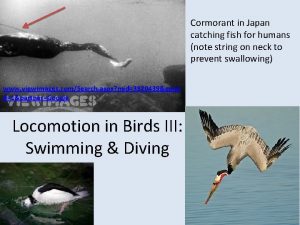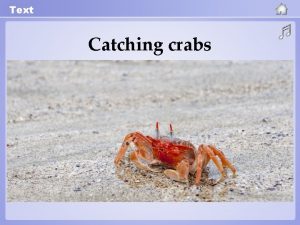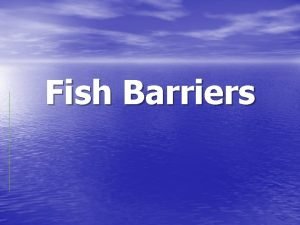Cormorant in Japan catching fish for humans note















- Slides: 15

Cormorant in Japan catching fish for humans (note string on neck to prevent swallowing) www. viewimages. com/Search. aspx? mid=3320439&epmi d=1&partner=Google Locomotion in Birds III: Swimming & Diving

Source: http: //www. oaklandzoo. org/atoz/video 22. html Swimming on the Surface • Swimming - aquatic birds (like Tufted Ducks) typically have: – low specific gravity (lightweight so very buoyant) – feathers with lots of barbules (less permeable) – well-developed uropygial gland – webbed feet – often much stored fat (buoyancy, energetics)

Swimming Below the Surface Anhinga sunning, near Ft. Myers, Fla • Anhinga swimming • http: //www. youtube. com/watch? v=o 2 s_D 040 OLA

Diving and swimming underwater • Birds that frequently dive and swim, such as grebes, cormorants, & loons, have: – relatively high specific gravities (heavier, less buoyant) – feet located well back on body for better propulsion and maneuvering underwater – and/or smaller wings that permit 'flying' underwater (e. g. , scoters, petrels, murres (video of Thick-billed Murres 'flying' underwater), and, of course, penguins -see the Adelie Penguin in 2 slides)

Pelican Diving

Adelie Penguin Source: http: //www. bionik. tu-berlin. de/intseit 2/xs 2 pinfi. html

• A) Bubbles in the wake of a Pigeon Guillemot (Cepphus columba) swimming horizontally, indicating intermittent thrust on downstroke • B) Wing positions during horizontal swimming by a Common Murre, as drawn from films taken at 32 frames/sec. Sequence is from left to right and top row to bottom row. Angle of attack of the wings suggests substantial lift during the upstroke (From: Lovvorn 2001) Swimming Underwater

Why Swimmers Have Small Wings I • Researchers believe small wings reduce drag underwater and are better suited for swimming • No concrete evidence • Studying the effects of wing area is difficult; crossspecies studies never give fair comparisons • Bridge (2004) studied the effect of altered wing size on Common Guillemots (Uria aalge) and Tufted Puffins (Fratercula cirrhata) during their brief molting periods (assumed molt = smaller wing = better swimming)

Wing-molt stages of a Tufted Puffin • Approximations of the percentage of intact wing area with the wing loosely extended are listed for each molt stage (Bridge 2004)

Why Swimmers Have Small Wings II: Puffin Swimming • Bridge (2004) used video cameras at Sea. World California mounting one camera in viewing window, and the other above the pool pointing straight down. • Plotted movement in 3 dimensions, calculated dive speed angle of descent • Found that wing molt had an adverse effect • During molt, the birds swam a shorter distance with each flap, and energy output, measured as work per flap, also reduced, especially when both primary and secondary feathers were missing • http: //www. youtube. com/watch? v=f. OM 6 Gwpr 2 r. I puffin

Why Swimmers Have Small Wings III • If reduced wing areas don’t improve diving/swimming ability, why has natural selection favored small, pointed wings in many aquatic birds? • Adept at high-speed, long-distance flight, essential for rapid movement between habitats - good • Small, pointed wings cannot generate lift at low speed, so rapid vertical takeoffs impossible – a problem? • Not a big problem for most diving birds because open aquatic habitats prevent close approach by undetected predators • When slow down to land, small wings stall easily, lose lift - good • High-speed hard landings more acceptable on water than on land • Aquatic habitats relax constraints on small, pointed wings. • -- Jane Qiu, Journal of Experimental Biology

Great Cormorant feathers have a regular and highly waterproof central part whereas the distal region is irregular and wettable. A ventral feather is shown (From: Grémillet et al. 2005). Double-crested Cormorants, Chatham, Cape Cod

Foot-propelled locomotion • When submerged, Great crested Grebes (Podiceps cristatus) swim with synchronized foot strokes, wings closely folded against the body • During the power stroke, the feet move from a cranial and ventrolateral position to a caudal and dorsomedial position relative to the body. • The mean swimming speed varied from 0. 7 - 1. 2 meters/sec (Johansson and Norberg 2001).

Foot Propulsion • Dorsal (left) & lateral (right) frames of a diving grebe • The dorsal view recorded after reflection from a mirror Photo source: http: //www. copyright-freepictures. org. uk/animals/birds/90 -great-crested-grebe. htm

One rude penguin
 One fish two fish red fish blue fish ride
One fish two fish red fish blue fish ride Flightless cormorant adaptations
Flightless cormorant adaptations Placoid scales meaning
Placoid scales meaning Twofish and blowfish
Twofish and blowfish Europe and japan in ruins
Europe and japan in ruins Catching killers fire investigation
Catching killers fire investigation Poppies poem context
Poppies poem context Attitudes are contagious is yours worth catching
Attitudes are contagious is yours worth catching Dog catching brian
Dog catching brian Whats signal words
Whats signal words Note taking definition
Note taking definition Debit note meaning
Debit note meaning Difference between note making and note taking
Difference between note making and note taking A simple discount note results in
A simple discount note results in Goods received note
Goods received note Difference between note making and note taking
Difference between note making and note taking



























